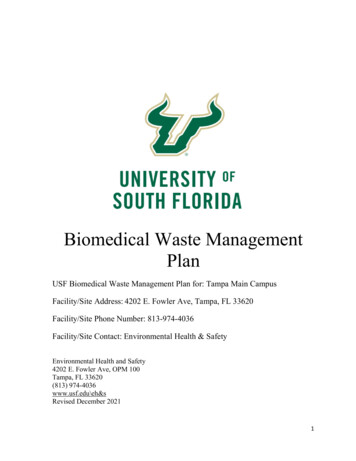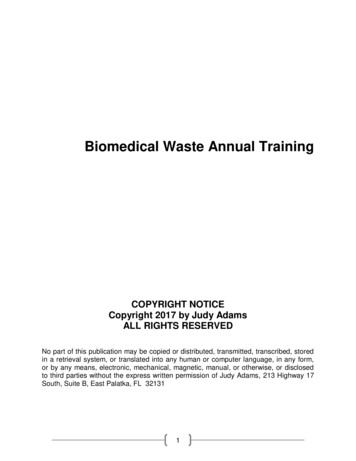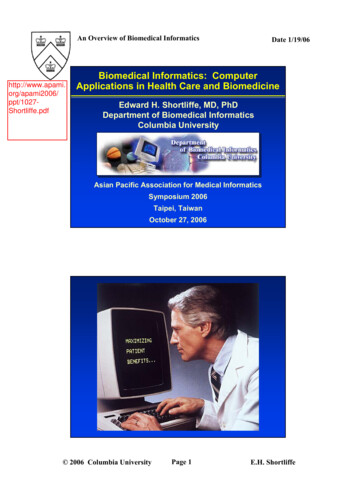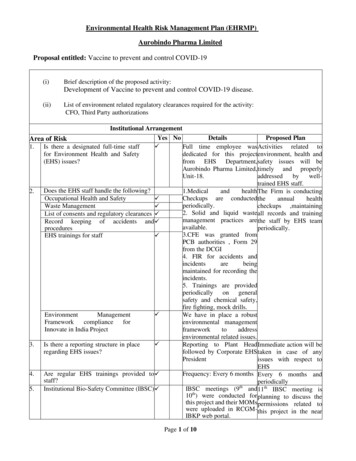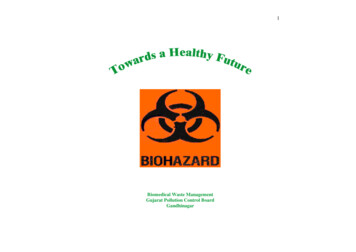
Transcription
Biomedical WasteManagementManual
CONTENTSChapter I:Introduction: Biomedical waste (BMW)Chapter II:BMW Management at IRSHAChapter III:Salient features of BMW Management rules, 2016Annexure:a. Authorization of IRSHA under Bio-medical Waste Management rulesb. Consent to Operate under the Air (Prevention & Control of Pollution) Act1981, and Water (Prevention & Control of Pollution) 1974c. Authorization of IRSHA with Passco, Environmental solutions, Ltdd. WHO Blue book, 2014e. BMW management rules, 2016/18f. Guidelines for bar-coding system for BMW management
THINK OUTSIDE THE TRASH Reduce, reuse, recycle, replenish!!Did you know?Recycling 1 aluminium can saves enoughenergy to run a TV for 3hours!One man’s trash is another man’streasure .
Chapter I:IntroductionWhat is biomedical waste (BMW)?“Bio-medical waste" means any wastegenerated during the diagnosis, treatmentorImmunization of human beingsorAnimals or research activities pertaining theretoorIn the production or testing of biologicals.
What is Not Biomedical Waste? Kitchen or domestic wasteOffice generated waste, paper wasteNon-hazardous chemicalsScrap metalElectronic wasteWooden cardboards
Need for BMW managementBMW may haveserious public healthconsequences and a significantimpact on the environment!
WHOhasestimatedthat.In year 2000, injections with contaminated syringescaused: 21 million hepatitis B virus (HBV) infections (32% of allnew infections)2 million hepatitis C virus (HCV) infections (40% of allnew infections)2.6millionHIVinfections(5%ofallnew)
Health disaster associated with the re-useof contaminated syringesAn outbreak of Viral Hepatitis B in ModasaTown, GujaratIn the year 2009, Modasa town of Sabarkantha district,Gujarat witnessed the outbreak of hepatitis B virus.Around 800 cases and 1000 contacts were evaluated for thevirus. Investigations revealed that the root cause of thisoutbreak was inadequately sterilized needles and syringes.Unsafe injection practices by private practitioners in theModasa town and surrounding areas directed thetransmission of this virus. This outbreak was of seriousconcern as it lead to the death of 100 cases. Within fourmonths of this incident, doctors and traders involved facedserious penalty. This incident puts light on the importanceof pre-treatment of biomedical waste especially whilehandling this virus.Source: Patel et al., 2012. J Glob Infect Dis. 2012 Jan;4(1):55-9
Chapter II:BMW Management at IRSHASTEPS INVOLVED
Segregation It refers to the basic separation of differentcategories of waste generated at source Reduces the risks and cost of handling anddisposal Effective segregation alone can ensure effectivebio-medical waste management
Categories of BMWCategoryYellowType of Bag/containerusedNon-chlorinated plasticbagsSeparate collection systemleading to effluenttreatment systemRedWhiteBlueType of wastea.Human anatomical wasteb. Animal anatomical wastec.Soiled wasted. Expired or discardedmedicinese.Chemical wastef.Micro, other clinical labwasteg.Chemical liquid wasteNon-chlorinated plasticbags or containersContaminated waste (Recyclable)Tubing, bottles, IV tubes and sets,catheters, urines bags, syringes(without needles) and gloves(Translucent)Puncture, Leak, tamperproof containerWaste sharps including MetalsCardboard boxes withblue colored markingGlassware
YELLOW BINHuman and animal anatomical waste, soiledwaste, expired or discarded medicines, logy and other clinical laboratory waste
RED BINContaminated Waste (Recyclable)Wastes generated from disposable items such astubing, bottles, intravenous tubes and sets,syringes (without needles and fixed needlesyringes) and vacutainers with their needles cut)and gloves
BLUE BINGlasswareBroken or discarded and contaminatedglass including medicine vials andampoules except those contaminated withcytotoxic waste
WHITE CONTAINERWaste sharps including MetalsNeedles, syringes with fixed needles, needlesfrom needle tip cutter or burner, scalpels, blades,or any other contaminated sharp object that maycause puncture and cuts. This includes bothused, discarded and contaminated metal sharps.
BMW Pretreatment (yellow category) On-site pre-treatment of laboratory waste,microbiological waste, blood samples, bloodbagsMethods Chemical disinfectionAutoclave
Chemical/liquid waste Some chemicals require pre-treatment before they canbe safely disposed of by other types of disposalmethods. Liquid laboratory wastes that are commonly disposedof in the sink include used buffer solutions, neutralizedacids and caustics, and very dilute aqueous solutions ofwater-soluble organic solvents (e.g., methanol,ethanol). Any form of liquid waste should be diluted with atleast a 100-fold excess of water or with a large excess ofwater up to 10 gallons. Acids should be neutralised with an equal volume of abase and further diluted in water to flush into the sink.In case of chemical spills . . . Acid spills should be neutralized with sodiumbicarbonate and then cleaned up with a paper towel orsponge. If the spill water contains bacteria, clean the area withbleach and dispose of the paper towels and gloves asbiological waste.Ref: Prudent Practices in the Laboratory: Handling and Management of Chemical Hazards, UpdatedVersion, 2011. . National Academies Press, Washington, D.C. https://doi.org/10.17226/12654
AutoclavingEach autoclave should have graphic or computerrecording devices which will automatically andcontinuously monitor and record dates, time ofday, load identification number and operatingparameters throughout the entire length of theautoclave cycleAll records to be kept for 05 yearsGravity displacement type where air is pushed out of the autoclave bysteam under pressure This system operates at temperatures of 121 Cand has a cycle time of approximately 60 - 90minutes
Validation test for autoclave Use four biological indicator strips , one is used asa control and left at room temperature, Three will be placed in the approximate centre ofthree containers with the waste Frequency: Conduct this test three consecutivetimes to define the minimum operating conditions The temperature, pressure and residence time atwhich all biological indicator vials or strips forthree consecutive tests show complete inactivationof the spores Follow – on action once in three months andmaintain records
Temporary storage of BMWThe bags containing lab waste arebrought for safe retention to thetemporary storage facility till they aredisposed off
Transport Offsite transport is the carriage of health-care waste onthe public streets away from a health-care facilityBiomedical Waste from storage area is transferred to thecommon regional facility for BMW final disposal Passco Environmental Solutions Pvt.Ltd, MPCB,Pune.
Personal protective equipment (PPE)Use of appropriate PPE mandatory whensegregating, packing, transporting, and storingBMW.
Chapter III:BMW Management Rules, 2016As relevant to IRSHAThese rules don’t apply for: Radioactive wastes Hazardous chemicals Lead acid batteries E-waste Municipal solid wastes Hazardousmicroorganisms,microorganisms and cellsgeneticallyengineeredFeatures of management rules everyone should know a. The scope of the rules has been expanded to includevaccination camps, blood donation camps, surgical camps orany other healthcare activityb. Phase-out the use of chlorinated plastic bags, gloves andblood bags within two yearsc. Pre-treatment of the laboratory waste, microbiological waste,blood samples and blood bags through disinfectionsterilization on-site in the manner as prescribed by WHO orNACOContd . . .
d. Provide training to all its health care workers andimmunize all health workers regularly.e. Establish a Bar-Code System for bags or containerscontaining bio-medical waste for disposal.f. Report major accidentsg. BMW has been classified in to 4 categories instead of 10to improve the segregation of waste at source yellow,red, white and blueh. No occupier shall establish on-site treatment anddisposal facility, if a service of CBMWTF is availableat 75 km.i. Operator of a CBMWTF to ensure the timelycollection of bio-medical waste from the HCF andassist the HCF in conduct of training.
Important considerations by occupier 1. To provide a safe, ventilated and securedlocation for storage of segregated BMWwithin premises.2. Phase out use of chlorinated plastic bags,gloves and blood bags within two years fromthe date of notification of these rules3. Provide training to all its health care workersand others involved in handling of BMW.4. Immunizationagainsttetanus for workers.HepatitisBand5. Establish a Bar-Code System for bags orcontainers containing bio-medical waste to besent out of the premises.
Schedule ICategories of bio-medical wastesYellowRedBlueWhiteSchedule IIStandards for treatment and disposal of biomedical wastes Standards for waste autoclavingStandards for liquid wasteSchedule IIIList of Prescribed Authorities and theCorresponding Duties
Schedule IVLabels for BMW containers/bags (Part A)Biohazard symbolCytotoxic hazard symbolHANDLE WITH CARENote: Label shall be non-washable and prominently visible
Form 1: ACCIDENT REPORTING1. Date and time of accident:2. Sequence of events leading to accident3. The waste involved in accident4. Assessment of the effects of the accidents onhuman health and the environment5. Emergency measures taken6. Steps taken to alleviate the effects ofaccidents7. Steps taken to prevent the recurrence ofsuch an accident
FORM 2: As per Biomedical Waste Management Rules, 2016, theAuthorization (for operating facility) for the generation, collection,reception, treatment, storage, transport, and disposal is given below:
FORM 4 ANNUAL REPORT To be submitted to the prescribed authorityby 31 January every year Name of the occupier with Address Categories of waste generated and quantity[monthly average] basis Name of treatment facility with Address Category-wise quantity of waste treated Mode of treatment with details Any other information
!!!!!Non-compliance to these rules may lead to Imprisonment of five yearsORa fine of Rs. 1 lakhORBothAs per provisions of Environment (Protection)Act, 1986
Do’s & Don’tsDo’sDon’tsPrior segregation of waste is amustDo not allow the bags/ containersto overfillVaccination should be takenagainst Hep BThe waste bag should not behanging at the edgeWear heavy duty gloves whilehandling infectious wasteDo not transport the wasteby dragging the bags
Tie the biohazard bags whenDo not recap the needlesfilled up to 3/4th levelClean any spills with appropriateDo not throw needles indisinfectantbiohazard bags or nonpuncture proof containers
a. Authorization of IRSHA under Bio-medical Waste Management rules b. Consent to Operate under the Air (Prevention & Control of Pollution) Act 1981, and Water (Prevention & Control of Pollution) 1974 c. Authorization of IRSHA with Passco, Environmental solutions, Ltd d. WHO Blue book, 2014 e. BMW management rules, 2016/18 f. Guidelines for bar .
